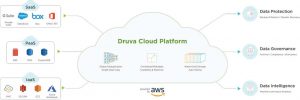Druva Cloud Platform Unifies Data Management Across Clouds
Extends data protection and governance capabilities to SaaS, PaaS and IaaS deployments, addresses complex data management needs.
This is a Press Release edited by StorageNewsletter.com on March 29, 2018 at 2:19 pmDruva, Inc. announced an update to its Cloud Platform to address the growing challenges posed as enterprises store more data in complex, heterogeneous cloud environments.
Click to enlarge
This Cloud Platform, which is available, offers a data management-as-a-service solution that unifies data protection, management and intelligence capabilities for business-critical data.
This update extends the platform capabilities for cloud applications, and customers can view and manage their data across SaaS (Software-as-a-Service), PaaS (Platform-as-a-Service) and IaaS (Infrastructure-as-a-Service) to ensure their data is properly managed through its lifecycle, meets enterprise SLAs, and achieves consistency of service regardless of where their data is ultimately stored.
Click to enlarge
Cloud Data Challenges
The cloud enables organizations to transition from legacy infrastructure, save money, and gain business agility for their data. However, once in the cloud, organizations experience a loss of visibility and control, making the data much harder to protect and manage.
Challenges include:
-
Patchwork of disparate systems– This can make data protection a nightmare as a mix of on-premise, hybrid and public cloud infrastructures proliferates, requiring multiple systems that must be administered separately, oftentimes in very different ways.
-
Different clouds have different data management needs – IaaS, PaaS, and SaaS have different protection and data management requirements that range from simple resiliency needs like backup and DR to more complex governance such as compliance, search and legal data handling.
-
Data protection/data management for cloud is inefficient, costly and kludgy – Using a mix of on-premise, hybrid and non-native public cloud services for data protection can drive up costs and administration overhead that offset any savings from using the cloud in the first place.
-
Growth of data – As the cloud provides yet another area to store and manage data, IT teams must deal with growing data lifecycle complexity, including managing data over time for long term retention and archiving. If not done properly, lack of management can equate to high costs due to collecting too much dark data.
“Moving data to the cloud is not a panacea,” said Dave Packer, VP, product and alliances marketing, Druva. “If a company’s data management is a mess while it exists in-house, then exporting it to the cloud can introduce even more data management challenges, and the increased cost to fix these can offset any anticipated savings.“
Click to enlarge
Cloud Platform meeting the challenges
The company cloud-native architecture and pay-as-you-consume data management-as-a-service platform means that companies do not need to invest in additional hardware or special software. Unlike other solutions on the market, the Cloud Platform readily scales to accommodate terabytes or petabytes of data due to its cloud-based architecture.
- Protecting disparate systems – the Cloud Platform provides a single point of data management and protection for workloads in the cloud. With integrated visibility and management into the firm’s Apollo, inSync and Phoenix services, the platform enables enterprise customers to achieve consistency of data protection and lifecycle management across environments, including following the data when workloads move (e.g. from on-premises to VMware on AWS, to AWS native environment.)
-
Different clouds have different data management needs – Cloud Platform’s single management control plane ensures that the right rules are in place for all enterprise data, as well as customizing those rules where it is appropriate or required to do so.
-
Reducing data protection/data management costs – ‘Lifting and shifting’ on-premises backup/recovery into the cloud results in inefficient compute and storage usage, backing up the cloud to on-premises is resource intensive, complicating administration and adding significant cost. The Cloud Platform is implemented natively on AWS, providing streamlined storage management, elasticity and scale throughout the lifecycle of data, resulting in up to 60%+ TCO savings.
-
Exponential growth of data – Global data deduplication and consolidation of multiple storage and DR products into one combine to reduce the growth of storage requirements while still ensuring you can protect all necessary company data. Automated lifecycle management reduces costs still further over time.
Benefits include:
-
Backup and recovery for SaaS services: Enables fast data restoration in case of accidental deletion or ransomware corruption for Salesforce, Microsoft Office 365, Google, Box, and more
-
Archiving and long-term retention: Efficient storage management that automatically tiers data to lower cost storage as it ages, regardless of the cloud source, data can be maintained long-term for compliance and legal purposes, with no need for tape storage
-
VMware on AWS integration for workload mobility and fast recovery: VMware, Inc.‘s customers can span data protection across on-premises and VMware cloud environments, allowing on-premises server failure to be instantly spun-up in AWS or restored in minutes into the VMware cloud
-
Integrated console/dashboard: Used for comprehensive data management and protection, including analytics, governance and visibility into data across heterogeneous environments
-
Protection and lifecycle management of IaaS/PaaS service data: Enables organizations to manage the protection, archiving and recovery of cloud native services’ (AWS RDS, AWS S3, AWS EBS, and other) data to ensure resilience and continuity.
The Druva Cloud Platform is available.

















 Subscribe to our free daily newsletter
Subscribe to our free daily newsletter


